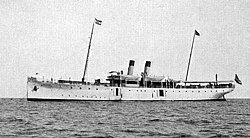Silvana (ship, 1897)
|
The Silvana 1902
|
||||||||||||||||||||
|
||||||||||||||||||||
|
||||||||||||||||||||
|
||||||||||||||||||||
|
||||||||||||||||||||
The Silvana was a German seaside resort ship that served Heligoland and the East Frisian Islands .
Construction and technical data
The ship, with two masts and two slightly reclined chimneys, ran on 24 April 1897 the shipyard of Howaldtswerke in Kiel for the North Sea Line Steamship GmbH of Hamburg shipowner Albert Ballin from the stack . It was 72.7 m long and 9.0 m and measured 804 GRT . The passenger capacity was 618 people and the speed of the twin-screw steamship was 14 knots . The maiden voyage took place on June 2, 1897.
career
From the summer of 1897 the ship sailed between Helgoland, Norderney and Borkum .
From the autumn of 1899 and in 1900, Silvana Jonathan Zenneck , assistant to the Strasbourg professor Ferdinand Braun , was used to test wireless radio communications over long distances by sea. The tests began in April 1899 with a transmitter at the lighthouse at the Alte Liebe in Cuxhaven and a receiver at the Kugelbake . A transmitter was also installed on the Silvana so that the distance could be extended further and further as soon as reception was registered. On September 25, 1900, a radio link was established for the first time up to Helgoland, 62 km away .
The Silvana was later one of the three ships that were equipped for test purposes in 1907 and 1908 with a ship's gyro developed by Ernst Otto Schlick and designed as a steam turbine , which served to dampen the rolling, rolling and pitching movements that occur in rough seas. The swing ring of the ship's gyro of the Silvana had a diameter of 1.6 m, a weight of approx. 5100 kg and was operated at approx. 1800 rpm. However, due to unsatisfactory results in the transmission of the gyroscopic movement in further ship tests, Schlick's ship gyro was not widely used.
With the takeover of the North Sea Line on January 1, 1905 by HAPAG , of which Albert Ballin had been General Director since 1899, HAPAG assumed the leading role in the seaside resort service on the North Sea coast. As a result, nothing changed in the service of the Silvana until the beginning of the First World War , even if she was based in Cuxhaven in the last years before 1914 . Then the seaside resorts were closed, the service stopped and the seaside resort ships were called in by the Imperial Navy as auxiliary ships. The Silvana was put into service on August 1, 1914 under the command of Korvettenkapitän Max Forstmann as an auxiliary steamer C in the North Sea and was taken out of service three days later due to "weak deck formations". On August 6, the ship moved to Wilhelmshaven and, after minor modifications, was used as a pilot ship for the outpost flotilla of the North Sea until November 1914, then from March 1915 as a pilot ship for the commercial protection flotilla in the Baltic Sea until 1918.
After the war, the Silvana was delivered to France in 1919 , and it is said to have been used between Marseille and Corsica . However, it was bought back by HAPAG as early as 1920. It was then converted for service on the Hamburg- Danzig line , with 200 cabin seats. She made her first trip on her new line on March 4, 1921.
On November 14, 1924, it was sold to Hamburg to be scrapped.
Individual evidence
- ↑ Original advertisement of the shipping company Nordsee-Linie from 1897: Timetable Hamburg - Borkum
- ↑ Ferdinand Braun: Wireless telegraphy through water and air. Leipzig 1901. (Reprint: Severus Verlag, Hamburg 2010, ISBN 978-3-942382-02-1 , pp. 47-48.)
- ^ F. Braun: Wireless Telegraphy. In: The Electrical Journal. Volume 46, March 15, 1901, pp. 778-779. (online at: books.google.com )
- ↑ Elbe-Weser Radio / DAC; A historical review
- ↑ The other two were the experimental boat Seebär (the small 57-tonne torpedo boat Th 2 , built in 1884 and decommissioned by the Imperial Navy ) and the Lochiel , an English mail steamer.
- ^ Arnold Sommerfeld: Mechanics. (Lectures on Theoretical Physics, Volume I). Verlag Harri Deutsch, Thun 1994, ISBN 3-87144-374-3 , p. 135.
- ^ Tristan Perez: Ship Motion Control . Springer Verlag, Berlin / Heidelberg 2005, ISBN 1-85233-959-4 , p. 123 f.
- ↑ Bernd Langensiepen : Five days in August. The short episode of bathrooms steamer Silvana is an auxiliary Trust Mine steamer C . In: Marine-Nachrichtenblatt III / 2012, 3rd vol., Pp. 12–15. ISSN 2194-4334 .
literature
- Herbert Kuke: Helgoland course. Verlag Gerhard Stalling, Oldenburg 1974, ISBN 3-7979-1839-9 .
- Claus Rothe: German seaside ships from 1830 to 1939 . Steiger Verlag, 1989, ISBN 3-925952-07-1 .
